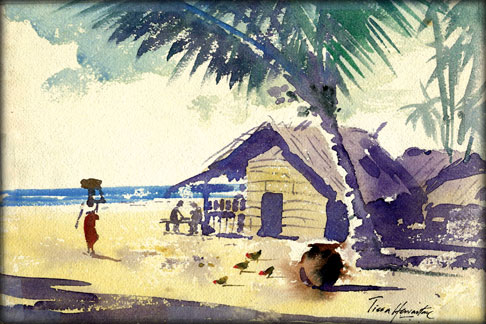How to make wise colour decisions
by Tissa Hewavitharane
I certainly do not suppose it is possible to cover the scope of
colour in a single article or even in a one thousand page book. What I
intend to do is to share some ideas that will provide a foundation on
which you can build a more rational, as well as expressive, approach to
making colour decisions.
At the most basic Level, colour is not complicated. Two colours are
placed side by side in a painting. You have the choice of either making
them different in a limited number of ways, or keeping them similar.
There are certainly times when one choice is better than the other. Poor
colour relationships happen when the artist does not consider the
choices. Unfortunate are the painters who paint exclusively in local
colour.
 They see the sky as blue, the grass as green, the house as white and
the farm as led. I use the word ‘see’ incorrectly for they don't see
anything. Rather they go to their memory bank of colour generalisation
and select a colour that was stored away as toddlers. They see the sky as blue, the grass as green, the house as white and
the farm as led. I use the word ‘see’ incorrectly for they don't see
anything. Rather they go to their memory bank of colour generalisation
and select a colour that was stored away as toddlers.
Old habits
It's hard to break old habits. To improve your ability to see colours
correctly, never begin by asking the question, ‘what colour is it’ The
answer will be one-word generalisation too narrow scope to be of any
value. First determine what value it is somewhere between white and
black. Then decide what temperature it is warm or cool. Next ask what
the intensity is somewhere on the scale from pase, intensive colour to
neutral grey.
Having once, with sensitivity and intelligence, identify the colour
of a shape and place it on the paper, a series of decisions is set in
motion.
You will want to place a colour next to the first which will enhance
both. Keep in mind that contrasts are complementary. As dark values make
an ajacent light appear lighter, so also a warm elements its opposite.
Your choices are limited to value, intensity, temperature or various
changes.
An arrangement of shapes is essential to a great painting. Once you
have designed these shapes and drawn them on the page, the next
requirement is that you make them visible. One approach to making the
shapes and patterns of our painting visibly clear is separating them by
value contrast. When you do so, colour takes of secondary role. You need
only identify what value to make a shape. Forget the local colour and
establish the value contrasts that will make the shapes and composition
clear.
Nature's colours
It isn't necessary to use colour to paint, we compose with graphite
all the time. Since nature's colours tend to be warm and neutral, the
palletle is effective. It would not work if the goal was to express the
brilliant colours of a flower market. Value painters paint and observe
with their eyes squinted. They can generally be recognised by the
presence of crow's feet extending back to their ears. The impact of
value painter's work is in the contrast of values and texture. The best
of the value painters do not pretend to be colourises. They avoid strong
colour that compromises the effect of value contrast. A declaration of
intert is important to your artistic development.
Categories
Watercolours generally fall into two categories glazers and mingles.
Glazers work in sequential layers of pigments. This can be done in using
a-wet over-dry technique or dry-over-wet technique. Mingles are
generally less patient and prefer to mingle pigments or change colours
along a wet edge.
Many of the colours achieved in our paintings are the result of not
pigments used, but also when and how they're applied. The painting shown
here is based on applying several colours. The whole painting process is
an organised series of decisions about the next move. This keeps the
painting alive. Observe the painting the eye is always drawn to the
human figure. On the right are men seated playing chess. The centre of
the interest shows a woman fishmonger with a basket on her head carrying
fish. The entrance to the painting is at the bottom. The eye travels to
the foreground objects which are the nuts and the coconut trees and into
the main part of the painting travels around from object to object. In a
landscape the eye is always drawn to human figures. The two men seated
at the corner of the hut playing a game from the anchoring point for the
whole composition. The technical richness of this medium is such that
one of the most interesting techniques that it has is precisely the
opening up of white spaces. Notice the white spaces left on the trunk of
the coconut tree, the woman's jacket and the sky. To give more life to
the painting. I have introduced few birds picking up food. You will
observe this entire painting is done by brush without using the pencil.
This needs lot of experience, patient and hard work, and
concentrating of mind where to put the correct colours at the correct
time. Keeping this balance of constant practice within a framework of
understanding is the key success to a brilliant painting. |

